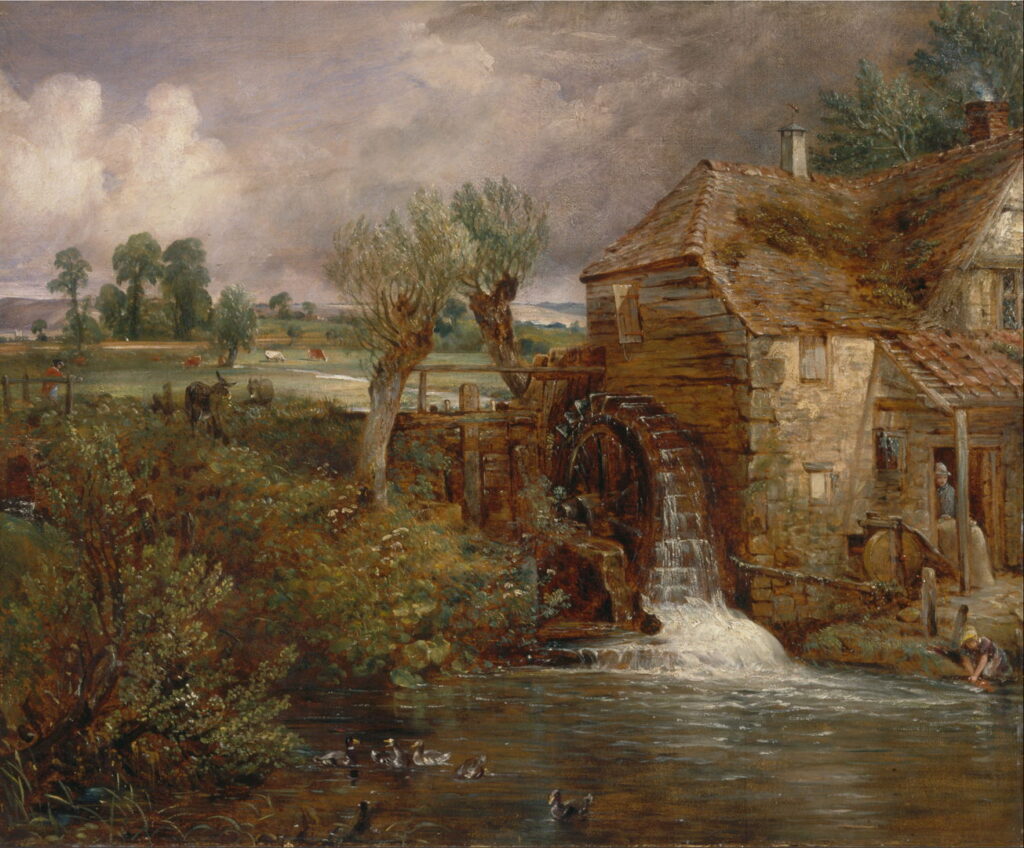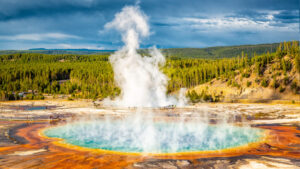The Real Country: 6 The mill

Despite their popularity as crops for millennia, cereals require preparation into more palatable form before they can form the mainstay of most diets, as one of the staple sources of carbohydrates, as they were across Europe before the popularisation of the potato after 1750. Wheat and rye were most commonly crushed into flour in mills, then that was baked into bread.
Early manual milling was replaced during classical times by mills driven by a range of natural power, including animals, wind and water. In 1786, the first steam-powered grain mill opened for business in London, although wind and water were to remain dominant in many rural districts until well into the twentieth century.
Windmills developed during the Middle Ages, and by 1500 were widespread across many parts of Europe. Although their design evolved and improved into the nineteenth century, their common principle is to expose rotating sails to wind, and transfer that rotating force to one of a pair of large millstones, within which the grain or grist is ground into flour.
Rembrandt Harmenszoon van Rijn (1606–1669), The Mill (1645-48), oil on canvas, 87.6 x 105.6 cm, National Gallery of Art, Washington, DC. Wikimedia Commons.
Rembrandt painted few non-narrative landscapes, but among them is his dramatic view of The Mill (1645-48) seen in the rich rays of twilight. This is a post mill, whose wooden top was turned into the wind to set its sails turning. It’s sited on a small hill giving it the greatest exposure to wind.
Jacob van Ruisdael (1628/1629–1682), The Windmill at Wijk bij Duurstede (c 1670), oil on canvas, 83 x 101 cm, Rijksmuseum Amsterdam, Amsterdam, The Netherlands. Wikimedia Commons.
The great masters of Dutch landscape art like Jacob van Ruisdael must have painted many hundreds of windmills, of which one of the best-known is this view of The Windmill at Wijk bij Duurstede from about 1670. This small town, now a city, is on the bank of the River Rhine, an ideal location for delivering sacks of grain by barge, and shipping the resulting sacks of flour. This should have kept this tower mill as busy as the wind allowed, and its owner prosperous.
John Varley (1778–1842), Red House Mill, Battersea, Surrey (date not known), watercolour and graphite on medium, slightly textured, cream wove paper, 24.4 × 34.3 cm, Yale Center for British Art, New Haven, CT. Wikimedia Commons.
The British topographic painter John Varley painted this close-up view of the well-known Red House Mill, Battersea, Surrey, with its good access by barge and proximity to the city of London. This is a wooden smock mill, a design pioneered by the Dutch in the seventeenth century.
Samuel Palmer (1805-1881), Summer Storm near Pulborough, Sussex (c 1851), watercolour on paper, 51.5 x 72 cm, Art Gallery of South Australia, Adelaide. Wikimedia Commons.
Samuel Palmer’s Summer Storm near Pulborough, Sussex from about 1851 refers to Dutch landscape painting, but in a very Kentish context. A storm is seen approaching the rolling countryside near Pulborough, now in West Sussex, in the south-east of England. On the left, in the middle distance, a small bridge leads across to a hamlet set around a prominent windmill, whose blades are blurred as they’re driven by the wind. Beyond that mill are fields of ripening cereal.
Some windmills used their power to cut wood in sawmills, and others raised water, tasks also powered by water in watermills. These were of even more ancient origin, devised by combining waterwheels with toothed gears in the couple of centuries before the Christian era.
George Morland (1763–1804), The Old Water Mill (1790), oil on canvas, 100.3 x 124.8 cm, Yale Center for British Art, New Haven, CT. Wikimedia Commons.
The Old Water Mill from 1790 is one of British painter George Morland’s finest landscapes, and shows a small undershot watermill deep in the English countryside.
James Ward (1769–1859), An Overshot Mill (1802-1807), oil on panel, 27.6 x 33.3 cm, Yale Center for British Art, New Haven, CT. Wikimedia Commons.
A contemporary of Morland, James Ward wasn’t shy of showing the increasing dereliction in the troubled British countryside at this time. An Overshot Mill (1802-1807) shows a rickety overshot watermill used for the grinding of grain. Its fabric is in dire need of repairs, and the thatchers are already making a start on its roof.
John Constable (1776–1837), Parham Mill, Gillingham (c 1826), oil on canvas, 50.2 x 60.3 cm, Yale Center for British Art, New Haven, CT. Wikimedia Commons.
John Constable’s contrasting view of Parham Mill, Gillingham from about 1826 shows an undershot watermill near the town of Gillingham in Dorset, visited by the artist during the early 1820s. Also known as Parham’s Mill and later Purns Mill, it burned to the ground in 1825.
Albert Bierstadt (1830–1902), A Rustic Mill (1855), further details not known. Wikimedia Commons.
When the German-American landscape artist Albert Bierstadt was painting in Düsseldorf, Germany, in 1855 he made this idyllic view of A Rustic Mill which is clearly overshot, being fed along a wooden aqueduct. In contrast to many of the other paintings of mills from this period, this appears in an excellent state of repair and prosperous.
Nikolai Astrup (1880–1928), Going to the Mill (c 1900-05), oil on canvas, 45 x 56 cm, Bergen Kunstmuseum, KODE, Bergen, Norway. The Athenaeum.
Nikolai Astrup’s Going to the Mill from about 1900-05 is a complete essay on watermills, pictured in perfect rainy milling weather, with the streams in spate during the autumn/fall. A mill race, running down its wooden channel, feeds a small undershot paddle in the centre, used to turn a millstone for sharpening knives and tools. Water flow to that is regulated by the simple valve upstream, currently in the off position, and shedding the water to either side. The man and his son are taking a sack of grain up to another mill, possibly the small shed seen in the centre distance, to grind flour for the family’s baking.
That completes my pictorial account of cereals in arable farming prior to mechanisation, from plowing the soil to milling the grain into flour. Pure arable farming was unusual, though, and the companions to fields of cereals were often sheep, the subject of next week’s article.


